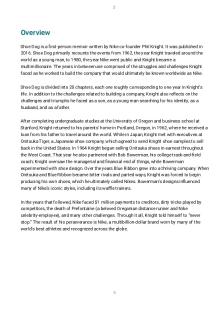Mu of the shoe - What sports shoe offers the greatest amount of traction as reflected by the PDF

| Title | Mu of the shoe - What sports shoe offers the greatest amount of traction as reflected by the |
|---|---|
| Author | ragenee iqbal |
| Course | Conceptual Physics Laboratory |
| Institution | Queens College CUNY |
| Pages | 3 |
| File Size | 127.9 KB |
| File Type | |
| Total Downloads | 85 |
| Total Views | 129 |
Summary
What sports shoe offers the greatest amount of traction as reflected by the coefficient of static friction values...
Description
NAME_________________ DATE__________ TEACHER_______________
MU OF THE SHOE LAB Question What sports shoe offers the greatest amount of traction as reflected by the coefficient of static friction values?
Purpose: ● To determine the coefficient of static friction for a variety of shoes. ● To evaluate the effectiveness of the shoes in terms of providing traction. Materials Required: ● Sports shoes
● Spring Scale
● Assorted Masses
Procedure: Static Friction 1. Connect your spring scale to the shoe holding it vertically to determine its weight. This will also be the normal force on the shoe as you pull it on a horizontal surface. 2. Place the shoe back on the floor and begin to pull gradually until the shoe just slips. Make sure your pull is horizontal to the ground. If the force reading is too small to get an accurate reading, place some more mass to it. If this is the case, go back and re-weight it. a. The force which just budged the shoe is the maximum force of static friction between your shoe and floor. 3. Repeat Step 2, two more times and record and then determine the average static friction force. 4. Add more mass to the inside of your shoe (using other objects) and repeat steps 1. and 2, until you have 5 data points for this shoe. Record your results in Table 1 below. 5. Get a different shoe and repeat steps 1-4, recording these results in Table 2. STATIC FRICTION Table 1 Shoe Name
Weight = Normal Force (N)
Static Ffr Force Trial 1 (N)
Static Ffr Force Trial 2 (N)
Static Ffr Force Trial 3 (N)
Static Ffr Average (N)
“ “ “ “
STATIC FRICTION Table 2 Shoe Name
Weight = Normal Force (N)
Static Ffr Force Trial 1 (N)
Static Ffr Force Trial 2 (N)
Static Ffr Force Trial 3 (N)
Static Ffr Average (N)
“ “ “ “ 6. Plot a graph of the Static Friction Force vs Normal Force for each shoe on the same graph, or separate graphs.
Recall,
μ=
Static FrictionForce Normal Force
, so the slope of your graph is the
coefficient of static friction between your shoe and floor.
Be sure to show your slope calculation or give the equation of the best-fit line.
Recall, Quick Graph 4.0 can be helpful in plotting and determining the equation of best fit for each line.
Be sure to differentiate which shoe is which on your graph – use different colors for each shoe.
What Do You Think? [Include responses to at least 2 of these questions in your formal lab report.] 1. What effect on mu (coefficient of static friction) would moving your experiment to another surface have? Explain why you say this. 2. How do you think the weight of the athlete wearing the shoe would affect mu? Why? 3. Many athletes seem more concerned with their shoes than any other piece of equipment they use, and for good reason. Discuss how your findings support this reliance....
Similar Free PDFs

shoe modification thomas heel
- 42 Pages

The Greatest Showman
- 4 Pages

International Shoe v. Washington
- 2 Pages

Shoe Tying Template FREE
- 4 Pages

Alden Shoe Financial Fraud Report
- 10 Pages

The Hobbit Followed by The Lord of the Rings
- 1,347 Pages

Shoe Dog Summary and Analysis
- 41 Pages
Popular Institutions
- Tinajero National High School - Annex
- Politeknik Caltex Riau
- Yokohama City University
- SGT University
- University of Al-Qadisiyah
- Divine Word College of Vigan
- Techniek College Rotterdam
- Universidade de Santiago
- Universiti Teknologi MARA Cawangan Johor Kampus Pasir Gudang
- Poltekkes Kemenkes Yogyakarta
- Baguio City National High School
- Colegio san marcos
- preparatoria uno
- Centro de Bachillerato Tecnológico Industrial y de Servicios No. 107
- Dalian Maritime University
- Quang Trung Secondary School
- Colegio Tecnológico en Informática
- Corporación Regional de Educación Superior
- Grupo CEDVA
- Dar Al Uloom University
- Centro de Estudios Preuniversitarios de la Universidad Nacional de Ingeniería
- 上智大学
- Aakash International School, Nuna Majara
- San Felipe Neri Catholic School
- Kang Chiao International School - New Taipei City
- Misamis Occidental National High School
- Institución Educativa Escuela Normal Juan Ladrilleros
- Kolehiyo ng Pantukan
- Batanes State College
- Instituto Continental
- Sekolah Menengah Kejuruan Kesehatan Kaltara (Tarakan)
- Colegio de La Inmaculada Concepcion - Cebu








